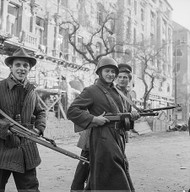Behind the Iron Curtain: The Hidden Story of Hungary's Special Breed of Kalashnikovs
Posted by Mark A. Taylor - AK Nut on Dec 14th 2023
When one thinks of the AK-47, Russia and Yugoslavia nations tend to come to mind first. However, Hungary quietly crafted one of the most influential variants of this revolutionary rifle during the Cold War. Through necessity and ingenuity, they forged a distinct breed of Kalashnikov unseen in the West. This is the little-known story of the Hungarian AK-47.
The Spark of Innovation Out of Ashes
After reluctantly siding with Germany earlier on, Hungary was routinely ravaged by Soviet troops advancing to Berlin. After a few years of this battering, Hungary in March 1944 was then invaded and occupied by Nazi Germany when Hitlers Reich discovered Hungarian Prime Minister Miklós Kállay had intentions of switching to side with the Allies. Cities and infrastructure were demolished by months of intense fighting. After the Nazi takeover in Hungary took hold, factories were forced to convert for German war production and then became subject to Ally bombing and targeting. By 1945, bombing and shelling left manufacturing capabilities in ruins.

Prime Minister Kállay Miklós in procession on Holy Trinity Square, along Holy Trinity Street, Buda Castle. 1943. Fortepan.
When the dust settled, Hungary fell firmly in the Soviet sphere. To rebuild its military within the Warsaw Pact, the country needed to remake its arms industry almost from scratch. It was a tall order, but the knowledge of indigenous arms engineers gave them hope.
History of the Hungarian AK from the AK55, AKM63, AMD65, to the AMP-69
Like many other Eastern Bloc countries, Hungary adopted the Kalashnikov AK-47 assault rifle in the early 1950s. The first Hungarian-produced AK-47s were designated the AK-55 and were manufactured by the Fegyver- és Gépgyár (FÉG) state arms plant. The AK-55 was a faithful copy of the Soviet AK-47, featuring a milled receiver, wooden furniture, and a fixed stock.
In the early 1960s, FÉG began developing its own variants of the AK-47. The first of these was the AKM-63, which was essentially a Hungarian copy of the Soviet AKM. The AKM-63 featured a stamped receiver, which was less expensive and easier to produce than a milled receiver. The AKM-63 also had a number of other minor modifications, such as a new pistol grip and a folding stock.
The next major Hungarian AK variant was the AMD-65, which was developed in the mid-1960s. The AMD-65 was designed for use by armored infantry and paratroopers, and featured a number of modifications to make it more compact and maneuverable. The AMD-65 had a shorter barrel, a folding stock, and a vertical foregrip.
In the late 1960s, FÉG developed the AMP-69, a variant of the AK-47 that was specifically designed to launch rifle grenades. The AMP-69 featured a number of modifications to make it safe to fire rifle grenades, including a reinforced receiver, a new muzzle brake, and a special grenade launcher attachment.
The AK-55, AKM-63, AMD-65, and AMP-69 were all used by the Hungarian military and police during the Cold War era. The AKM-63 eventually became the standard-issue Hungarian assault rifle, and the AMD-65 was also widely used by special forces units. The AMP-69 was less common, but was still used by some units for grenade launching.
Here is a brief summary of the history of each Hungarian AK variant:
AK-55: Faithful copy of the Soviet AK-47, manufactured by FÉG in the early 1950s.
AKM-63: Hungarian copy of the Soviet AKM, with a stamped receiver and a number of other minor modifications. Entered service in the early 1960s.
AMD-65: Compact and maneuverable assault rifle developed for use by armored infantry and paratroopers. Entered service in the mid-1960s.
AMP-69: AK-47 variant specifically designed to launch rifle grenades. Entered service in the late 1960s.
AK-63 /AMM models: In 1977 Hungary adopted the AK-63 as standard issue for infantrymen.

AK-63 pictured among a few other culturally relevant Hungarian firearms
All of these Hungarian AK variants are known for their reliability and durability. They are also relatively inexpensive to produce and maintain, which has made them popular with militaries and law enforcement agencies around the world.
Lasting Reputation, Secrets Brought to Light
After the USSR’s collapse opened the former communist bloc, Western collectors got their first glimpse of Hungary’s mysterious Kalashnikovs.
After the fall of the Soviet Union in 1991, Hungary began to transition to a NATO-standard military. As part of this transition, the Hungarian military began to replace its AK-47-based rifles with newer NATO-compatible rifles. However, a number of AK-47-based rifles, including the AKM-63 and AMD-65, are still in use by the Hungarian military and police today.
While geopolitics had mandated their anonymity, after the Berlin Wall came down, seasoned AK enthusiasts quickly realized the skill of FÉG’s engineers. These cultural alterations built upon the Soviet AK foundation through clever adaptation.
In addition to their use by the Hungarian military and police, Hungarian AK-47-based rifles have also been exported to a number of other countries. The AMD-65, in particular, has been popular with law enforcement and special forces units around the world.
Maybe in this synthesis, the innovative spark that first breathed uniqueness into Hungary’s AKs decades prior behind opaque curtains can be rekindled. If so, a new generation of exceptional Kalashnikovs incorporating both wisdom of the past and modern techniques may soon emerge, just as the boundary-pushing pioneers at FÉG would have envisioned.
Interested in kit building? Check out our latest post!

